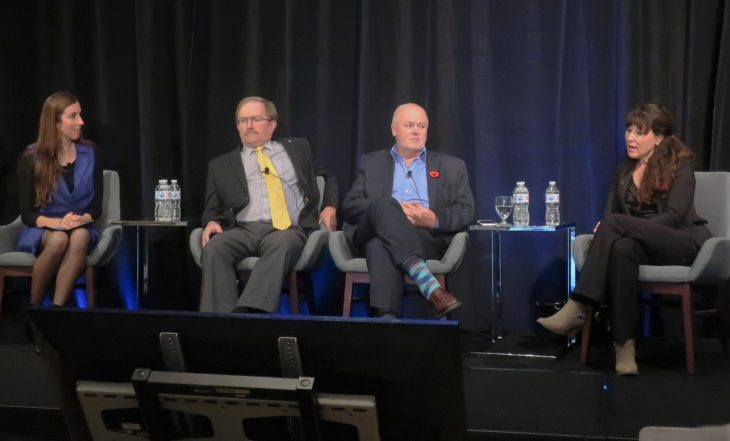
TORONTO – Together, Tim Denton, Peter Menzies and Candice Molnar have overseen some of the biggest decisions the CRTC has made over the past decade as former CRTC commissioners. Wouldn’t it be something to get them all together for a candid conversation about what they thought they got right and wrong and what they really think of the Regulator’s role?
Even more so now given we are in the midst of a legislative review of the Broadcasting, Telecommunications and Radiocommunication Acts. Dream no longer, that’s exactly what transpired on the last day of the 2018 Canadian ISP Summit in Toronto – and it was worth the wait.
The panel, moderated by the Financial Post’s Emily Jackson, served up the expected fireworks. Jackson began by asking the panellists their opinion of the current state of the CRTC.
“The CRTC needs to be split up” Denton said frankly to loud laughter and applause. “Broadcast issues and Internet should be dealt with separately.
He contended that Canadian cultural content should have its own separate government fund, not earned as a tax on cable subscriptions, as the system is now. “So you stop mixing the two. Should it be a cultural subsidy or industrial. And if it’s cultural how do you measure success?
Many in the creative sector believe there should be a contribution made by ISPs to the production of Canadian content.
Denton went on to ask “We spent $4 billion in the last 25 years on Canadian cultural content and what did we get from it? This weekend is the centennial of the armistice of the first World War and no one has yet made a film about Vimy Ridge.”
The Commission, he said, needs to focus its efforts on making the Internet more affordable, accessible and to develop a healthy digital ecosystem.
Molnar agreed with Denton and conceded the “Broadcasting Act does not speak for consumers… Appointed people are now determining the amount of subsidies that is paid by consumers. That should reside with elected officials.”
Before the panellists spoke out on the worst CRTC decisions, Jackson asked them about the best ones.
For Denton it was the 2009 decision on Internet traffic management practices. “Unlike the U.S., where there was a lunatic intensity around this we took the ideology out of it, and got that one right,” he said.
The 2016 decision that ruled access to broadband Internet service is a basic telecommunications right for all Canadians is one the regulator also got correct says Menzies. He’s also proud of the decision to stop the Bell-Telus merger in 2008.
For Molnar her pick for best decision was the ITMP decision, too. “That’s one of the times we were ahead of the curve. One of the few times where anyone you talked to in the industry thought it was a good decision, said Molnar.
“The idea of facilities based competition is one of the really gigantic stupid ideas of all time. It’s almost Marxist in its obsession with material objects as the basis of competition.” – Tim Denton
For worst decisions Denton called out the CRTC’s denial of mandated MVNO and Wi-Fi first broadband (which the Commission has said it will revisit next year). “The idea of facilities based competition is one of the really gigantic stupid ideas of all time.” It’s almost Marxist in its obsession with material objects as the basis of competition,” he added.
Menzies called the local programming improvement fund in 2008 (which added a small fee onto Canadians’ TV subscription bills to pay for local news content) as one of the “silliest things the CRTC ever did. They did this to respond to the so-called crisis in English TV. They but a fee on cable and a one-third of the funds went to French-language programming that was not in crisis.” He added one of the best decisions is when they killed the fund (although independent broadcasters do now have access to a different local news fund).
Also on Menzies’ list was “anything to do with 9(1)(h)” which is the Broadcasting Act clause which allows the Commission to require that a particular Canadian television channel be distributed by all (or a particular subset of) cable, satellite, IPTV, or similar subscription-based television service providers in Canada.
Finally the decision to end simultaneous substitution for Super Bowl advertising in 2016 rates as a low point for the CRTC according to Molnar who said there was “no justification” for it.
“The regulator should be independent and should not be swayed by public opinion” this way, she added.
“By and large the CRTC has done a pretty good job of managing the Internet,” said Menzies. “But at the same time until there is legislation clarifying net neutrality there will constantly be this pressure. There are so many vested interests that are still stuck in the 1980s with that system that worked very well for them.
“Everyone keeps trying to take this disruption, which is the Internet, and trying to make sense of it as broadcasting and cable. It’s not broadcasting, its not cable… to have a 1 per cent levy on it to subsidize content is crazy. [The CRTC] has tried to make the 21st century fit into the 20th century. They need to reverse that but I don’t know if they are capable of it.”



